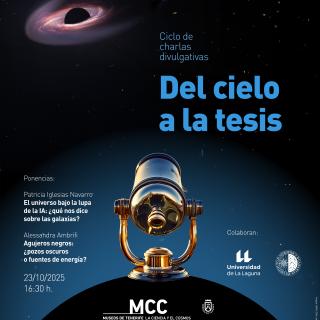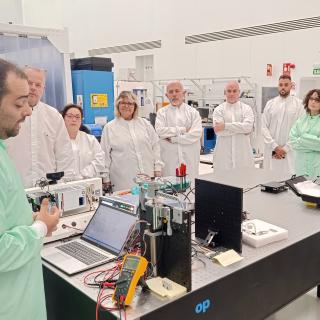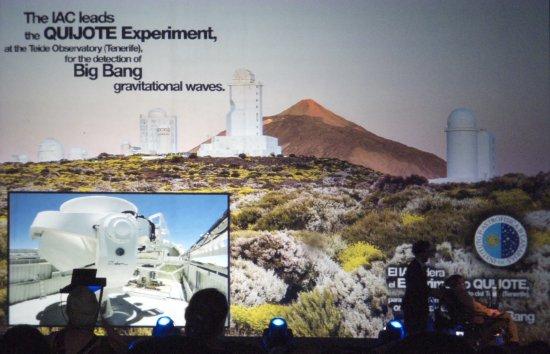It may interest you
-
 El Museo de la Ciencia y el Cosmos , del Organismo Autónomo de Museos y Centros del Cabildo de Tenerife, acogerá el próximo jueves 23 de octubre a las 16:30 horas una nueva cita del ciclo de divulgación científica “Del cielo a la tesis”, organizado en colaboración con la Universidad de La Laguna (ULL) y el Instituto de Astrofísica de Canarias (IAC). Este ciclo, impulsado por estudiantes de doctorado del IAC, tiene como objetivo acercar a la ciudadanía los temas más actuales de la investigación astrofísica contados en primera persona por quienes los desarrollan. Cada sesión, de carácterAdvertised on
El Museo de la Ciencia y el Cosmos , del Organismo Autónomo de Museos y Centros del Cabildo de Tenerife, acogerá el próximo jueves 23 de octubre a las 16:30 horas una nueva cita del ciclo de divulgación científica “Del cielo a la tesis”, organizado en colaboración con la Universidad de La Laguna (ULL) y el Instituto de Astrofísica de Canarias (IAC). Este ciclo, impulsado por estudiantes de doctorado del IAC, tiene como objetivo acercar a la ciudadanía los temas más actuales de la investigación astrofísica contados en primera persona por quienes los desarrollan. Cada sesión, de carácterAdvertised on -
 Cristina Ramos Almeida, investigadora del Instituto Astrofísico de Canarias (IAC) y coautora de más de un centenar de artículos sobre galaxias y agujeros negros, ha sido una de las homenajeadas en la primera edición de los premios "Mujeres tenían que SER" de Radio Club Tenerife, Cadena SER. El evento, celebrado en la noche del miércoles 29 de octubre, en la sala Adán Martín del edificio de Presidencia del Gobierno en Santa Cruz de Tenerife, ha teñido el espacio de reconocimiento al talento femenino en diversos ámbitos. La distinción resalta la crucial contribución de Ramos Almeida a laAdvertised on
Cristina Ramos Almeida, investigadora del Instituto Astrofísico de Canarias (IAC) y coautora de más de un centenar de artículos sobre galaxias y agujeros negros, ha sido una de las homenajeadas en la primera edición de los premios "Mujeres tenían que SER" de Radio Club Tenerife, Cadena SER. El evento, celebrado en la noche del miércoles 29 de octubre, en la sala Adán Martín del edificio de Presidencia del Gobierno en Santa Cruz de Tenerife, ha teñido el espacio de reconocimiento al talento femenino en diversos ámbitos. La distinción resalta la crucial contribución de Ramos Almeida a laAdvertised on -
 As part of Open Government Week, which is being held from 19 to 25 May, the Instituto de Astrofísica de Canarias (IAC) has organised open days at its facilities in La Laguna (Tenerife) to bring its research and technological activity closer to the public. This international initiative aims to promote the values of transparency, citizen participation and accountability in public administrations. The visits, in which dozens of people took part in different shifts, were held on Monday 19 May at the IAC headquarters and on Tuesday 20 May at the IACTEC building, the Institute's technological andAdvertised on
As part of Open Government Week, which is being held from 19 to 25 May, the Instituto de Astrofísica de Canarias (IAC) has organised open days at its facilities in La Laguna (Tenerife) to bring its research and technological activity closer to the public. This international initiative aims to promote the values of transparency, citizen participation and accountability in public administrations. The visits, in which dozens of people took part in different shifts, were held on Monday 19 May at the IAC headquarters and on Tuesday 20 May at the IACTEC building, the Institute's technological andAdvertised on
